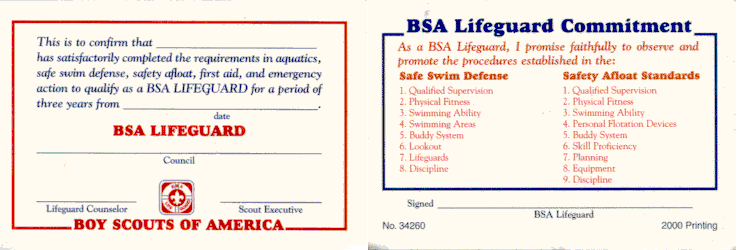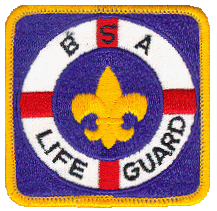Note: The requirements listed in the 2018 edition of Boy Scout Requirements were not revised to correspond to the requirements on the current application form.
To be trained as a BSA Lifeguard, you must successfully
complete the course as outlined in the BSA Lifeguard Instructor Manual
and demonstrate the ability to perform each item specified in the following
requirements:
Prerequisites
Before doing requirements 6 through 26, complete the following:
- Submit proof of age. You must be at least 15 years old to participate.
- Submit written evidence of fitness for swimming activities (signed health history).
- Swim continuously for 550 yards including at least 100 yards each of the following strokes, in good form: using the front crawl, or breaststroke, elementary backstroke, and sidestroke or a combination of either, but swimming on the back or side is not allowed.
- Immediately following the above swim, tread water for two minutes using the legs only and with the hands under the armpits.
- Starting in the water, swim 20 yards using a front crawl or breaststroke, surface dive 7 to 10 feet, retrieve a 10-pound object, surface, swim on your back with the object 20 yards back to the starting point with both hands holding the object, and exit the water, all within 1 minute, 40 seconds.
Requirements
Complete the following requirements within a 120-day period:
- Show evidence of current training in American Red Cross First Aid and American Red Cross CPR/AED for the Professional Rescuer or equivalent (includes any training for a camp health officer recognized by BSA national camp standards).
- Show evidence of current training in the BSA online module for Safe Swim Defense.
- Attend and actively participate in all activities, presentations, and skill sessions involving lifeguard behavior, duties, responsibilities, surveillance, intervention and water rescue as prescribed in the BSA Lifeguard Instructor Manual.
- 7. Demonstrate reaching assists from the deck using an arm, a rescue tube, and a pole.
- 8. Demonstrate throwing assists using a throw bag and a ring buoy with a line attached. Throw each device such that the line lands within reach of a conscious an active subject 30 feet from shore.
- 9. Demonstrate:
- Rescue of a conscious an active in deep water using a rescue board, kayak, rowboat, canoe, or other rescue craft that would be available at your local facility.
- Repeat for an unconscious passive subject.
- 10. Demonstrate an entry and front approach with a rescue tube to a conscious an active subject in deep water 30 feet away from shore. Position the rescue tube to support the subject and then assist the subject to safety, providing direction and reassurance throughout.
- 11. Demonstrate an entry and rear approach with a rescue tube to a conscious an active subject in deep water 30 feet away from shore. Secure and support the subject from behind and then move the subject to safety, providing direction and reassurance throughout.
- 12. Demonstrate use of a rescue tube to assist two subjects grasping each other. Secure, support, and reassure both subjects. With the assistance of a second guard, calm and separate the subjects and move them to safety.
- 13. Demonstrate both front and rear head-hold
escapes from a subject's grasp.
14. Demonstrate a feet-first entry in deep water with a rescue tube and swim an approach stroke 25 yards within 25 seconds while trailing the tube. - 15. Demonstrate an entry and front approach with a rescue tube to a face-down passive subject 30 feet away at or near the surface in deep water. Use a wrist roll to position the subject face-up on the rescue tube, tow them to safety, and remove them from the water with assistance within two minutes 90 seconds. Immediately perform a primary assessment and demonstrate one-person CPR for three minutes.
- 16. Demonstrate an entry and rear approach with a rescue tube to a face-down unconscious passive subject 30 feet away at or near the surface in deep water. Position the subject face-up, tow them to safety, and remove them from the water with assistance within two minutes. Immediately perform a primary assessment and demonstrate two-person CPR for three minutes.
- 17. Demonstrate In shallow water, demonstrate in-water ventilation of an unconscious subject when prompt removal from the water is not possible. Open the airway, position the mask, and simulate ventilations.
- 18. Demonstrate an entry and approach with a rescue tube for use when an unconscious a passive subject is submerged face-down at or near the bottom in 6 to 8 feet of water. Bring the subject to the surface and tow to the nearest point of safety.
- 19. Remove a subject from the water using
each of the following techniques in the appropriate circumstances with
the aid of a second rescuer:
- Vertical lift Extrication at the edge of a pool or pier using a backboard
- Walking assist
- Beach drag
- 20. Participate in multiple-rescuer search
techniques appropriate for a missing subject in murky water:
- Line search in shallow water
- Underwater line search in deep water without equipment
- Underwater line search in deep water with mask and fins
- 21. Demonstrate in-line stabilization for a face-down subject with suspected spinal injury in very shallow water (18 inches or less).
- 22. Demonstrate in-line stabilization for
a suspected spinal injury in shallow water (waist to chest deep):
- For a face-up subject
- For a face-down subject
- 23. Demonstrate in-line stabilization for
a suspected spinal injury in deep water, swim the subject to shallow
water, confirm vital signs, and with the assistance of three others,
remove the subject from the water using a backboard with straps and
a head immobilization device.
24. Demonstrate care for a spinal injury on land in the following situations:- a. Non-standing subject
- b. Standing subject including securing to a backboard and lowering to the ground
- Correctly answer 80 percent of the questions on the BSA Lifeguard knowledge test covering the course material. Review any incomplete or incorrect answers.
- Serve as a lifeguard, under supervision, for at least two separate BSA swimming activities for a combined time of two hours. Afterward, discuss the experience with the lifeguarding instructor.
Completion Options
Course completion cards are valid only when signed by either a current BSA Aquatics Instructor or BSA Lifeguard Instructor approved by the local council. Training is valid for two years, provided First Aid and CPR/AED for the Professional Rescuer training are kept current during that period.
There are five ways to obtain a course completion card:
- Course Completion — Complete all requirements in the instructor manual during a scheduled course of instruction. The participant must attend all course sessions. Makeup sessions are allowed at the instructor's discretion. If an individual is unable to complete all requirements during the scheduled course, the instructor may elect to continue training until the participant is able to complete all the requirements provided the total elapsed time from start to finish does not exceed the 120-day period.
- Renewal Challenge — Anyone with a BSA Lifeguard completion card that is current or has expired within six months may renew or extend the training by performing requirements 2 through 25 without attending the standard course sessions. Prior to the testing, the instructor may provide a renewal training session to review and update skills and information. Summer camp aquatics directors should renew training for aquatics staff members during precamp training while emphasizing local camp facilities, procedures, and emergency action plans.
- Crossover Challenge — Anyone who holds current training in American Red Cross Lifeguarding, American Red Cross Waterfront Lifeguarding, or other lifeguard training programs may obtain a BSA Lifeguard completion card by performing requirements 1 through 26 without attending the standard course sessions. The lifeguard training program that issued the training certificate must be recognized by the local or state regulatory agency that sets standards for lifeguards at youth camps. The instructor may provide a crossover training session to review and update skills and information prior to the testing. The applicant may receive credit for requirement 26 if within the past 18 months he or she has served as a lifeguard, under supervision, or has supervised lifeguards, for at least two separate BSA swimming activities for a combined time of two hours. Otherwise, due to BSA procedures not implemented at other lifeguarding venues, the applicant must accomplish requirement 26.
- Completion of BSA Aquatics Instructor — Anyone who completes BSA Aquatics Instructor training at National Camping School may obtain a BSA Lifeguard completion card.
- Co-Instructors — Co-Instructors (BSA Aquatics Instructor or BSA Lifeguard Instructor) may each sign a completion card for the other at the conclusion of a BSA Lifeguard course if they satisfy requirements 2 through 24.
BSA LIFEGUARD TRAINING PROCEDURE
- Only those persons currently certified trained as BSA Aquatics Instructor or as BSA Lifeguard Counselor Instructor may train the completion of BSA Lifeguard requirements
- Training as BSA Lifeguard is valid for two years from the date of completion.
- All requirements must be met. (See completion options.)
- The completed application is forwarded to the local council service center, where the individual's training record is annotated.
- To qualify for BSA Lifeguard, the candidate must complete the BSA Lifeguard course under the direction of either a BSA Lifeguard Instructor or a BSA Aquatics Instructor. The course for the BSA Lifeguard is in the BSA Lifeguard Instructor Guide Manual.
INSTRUCTOR'S RESPONSIBILITY
Scouts, Venturers, or adults who become trained BSA Lifeguards must be well-qualified and able to use their knowledge as a lifeguard in case of need without undue danger to themselves and with a reasonable chance of success. The instructors are responsible for the strict interpretation of requirements and the elimination of applicants who in their judgment are not qualified by strength, judgment, or ability to put their knowledge into practice as lifeguards. The reputation of the instructors as experts depends to a great extent on the actual performance of those they qualify. Therefore, they should be certain the candidate’s ability is, without doubt, of the highest caliber. It is expected that the BSA Lifeguard emblem and card will always stand for a very high standard of skill. The instructors to whom this responsibility is entrusted are expected to maintain that standard. For interpretation of requirements, see the BSA Lifeguard Instructor Manual.
In addition to the Patch shown at the top of this page, a wallet card (No. 34260) shown below, is available.

Source: Application for BSA Lifeguard (430-033WB - 2017 Revision)








